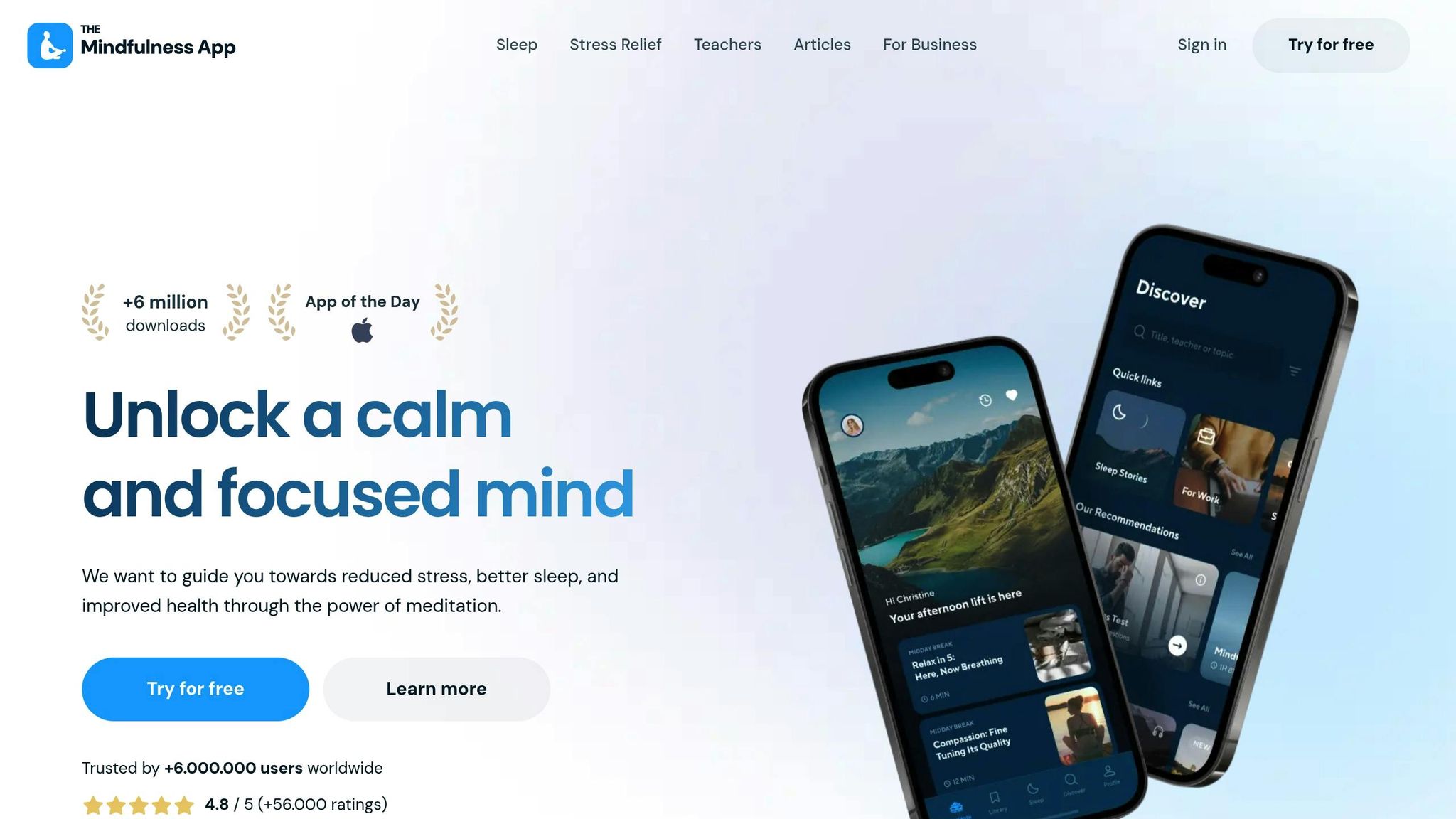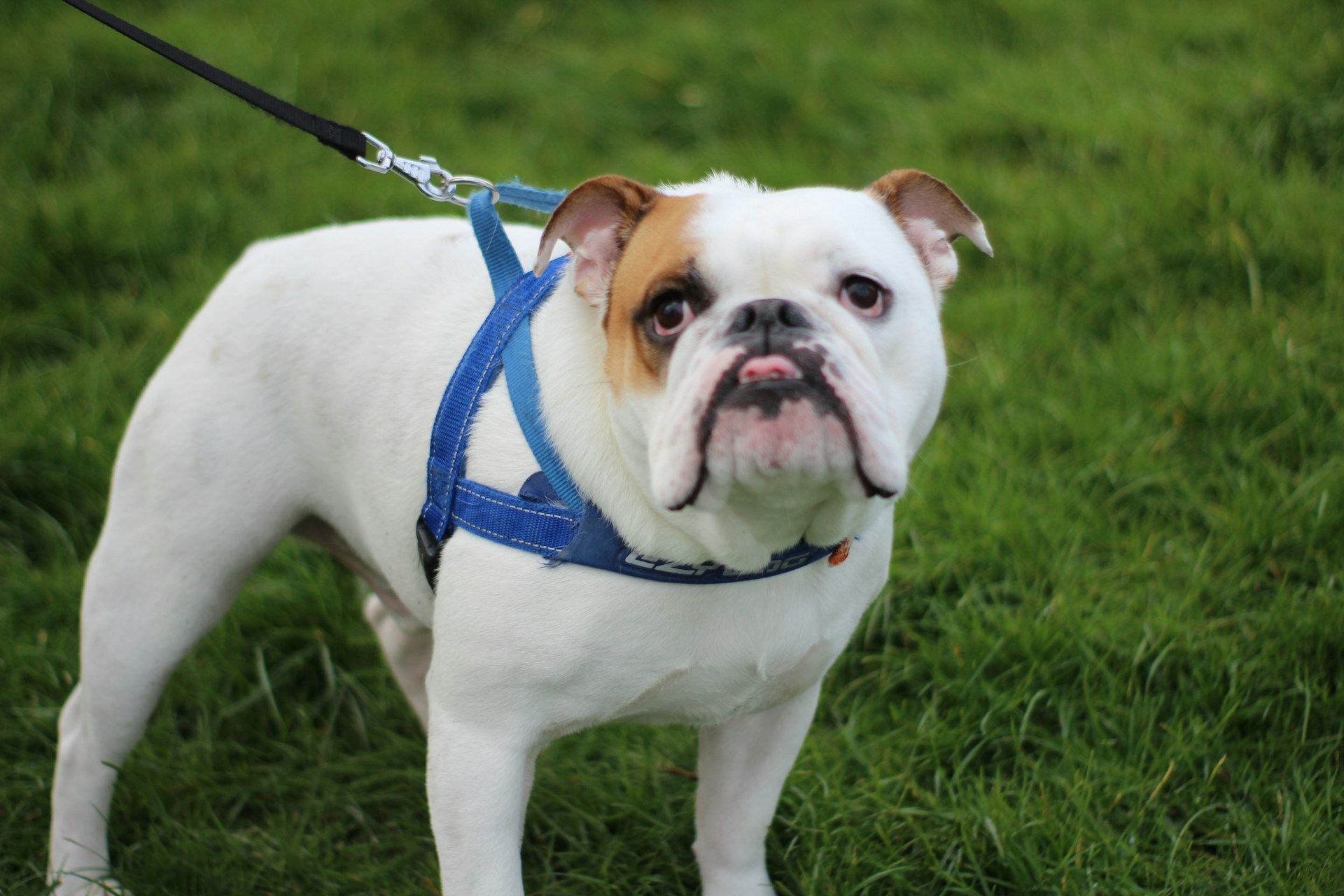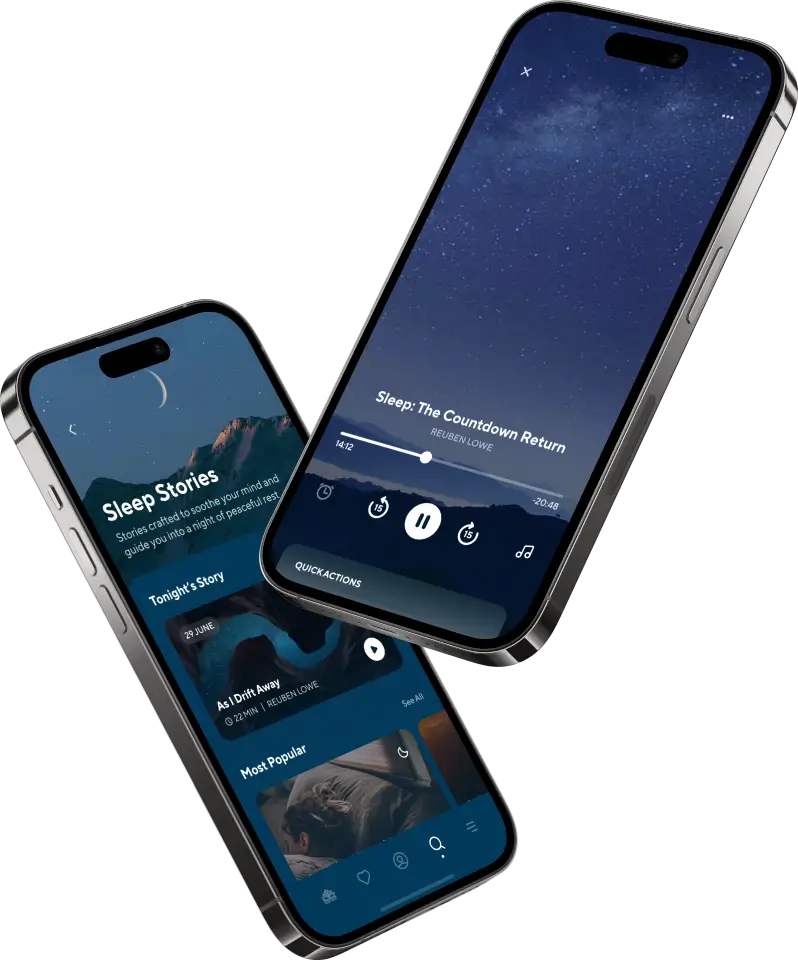When life feels overwhelming - deadlines, endless meetings, or constant notifications - quick mindfulness tools can help you regain focus and calm. These simple techniques, like deep breathing or grounding exercises, can be done in just a few minutes and fit into any routine. Here’s what you’ll learn:
- 3-Minute Breathing Space: A quick, three-step method to reconnect with the present.
- STOP Technique: A four-step process to pause, breathe, and reset during stressful moments.
- 5-Senses Grounding Exercise: Use your senses to stay present and reduce anxiety.
- Daily Integration: Pair mindfulness with everyday habits like commuting or eating for consistent practice.
Mindfulness doesn’t have to take hours. Even five minutes a day can lower stress, improve focus, and help you respond thoughtfully to challenges. Start small, and make these tools part of your routine.
Quick 5 Minute Meditation for Anxiety Stress Calm
Quick Mindfulness Techniques for Stress Relief
When stress hits, having quick, easy-to-use mindfulness tools can make a world of difference. These methods are designed to help you reset your mind in just a few minutes. The best part? You can do them almost anywhere - whether you're sitting at your desk, stuck in a meeting, or even during your daily commute.
3-Minute Breathing Space Method
This simple, three-step technique is all about reconnecting with the present moment. It takes just three minutes and works in three phases.
Step 1: Notice what’s happening.
Start by observing your current experience. Pay attention to your thoughts, emotions, and body sensations without trying to change or judge them.
Step 2: Focus on your breath.
Shift your attention to your breathing. Feel the air moving in and out of your nose or notice the gentle rise and fall of your chest.
Step 3: Expand your awareness.
Finally, broaden your focus to include your entire body. Notice any sensations, grounding yourself fully in the moment.
STOP Technique
The STOP technique is a quick and effective way to manage stress as it arises. It’s a mindfulness tool that helps you pause and respond thoughtfully instead of reacting impulsively. As explained by Cognitive Behavioral Therapy Los Angeles:
"The STOP Skill highlights how mindfulness can be used not just in meditation, but in everyday situations - helping individuals navigate difficult emotions and actions with greater clarity and control."
Here’s how it works:
S: Stop.
Take a deliberate pause to interrupt automatic reactions.
T: Take a breath.
Focus on a slow, mindful breath to help center yourself.
O: Observe.
Notice your thoughts, emotions, and surroundings without judgment.
P: Proceed mindfully.
With clarity, choose your next step intentionally.
5-Senses Grounding Exercise
The 5-4-3-2-1 grounding method is a go-to technique for calming anxiety. By tuning into your senses, it shifts your focus away from overwhelming thoughts and anchors you in the present. As the Calm Editorial Team notes:
"The 5-4-3-2-1 method works because it engages multiple senses, requiring you to concentrate on the present environment rather than dwell on anxiety-inducing thoughts. This interrupts the fight-or-flight response, calming the nervous system and reducing symptoms of anxiety or stress almost immediately."
Here’s how to do it:
- 5 things you can see: Look around and identify five specific objects or details.
- 4 things you can touch: Notice four different textures or sensations, like the fabric of your clothes or the surface of a nearby object.
- 3 things you can hear: Tune into three distinct sounds, whether it’s birds chirping, office chatter, or your own breathing.
- 2 things you can smell: Identify two scents, even if they’re subtle.
- 1 thing you can taste: Focus on any lingering flavor or simply the neutral taste in your mouth.
Practicing this regularly can help you stay calm and grounded, even during moments of intense anxiety.
Adding Mindfulness to Daily Routines
Incorporating mindfulness into your daily life becomes easier when you link it to your regular routines. By anchoring these practices to everyday activities and setting gentle reminders, mindfulness can naturally become part of your lifestyle.
Using Environmental Cues
Your surroundings can act as powerful triggers for mindfulness. For instance, mindfulness apps can provide guided meditations, breathing exercises, and reminders to pause and be present. Even setting a simple alarm on your phone can prompt a quick mindful moment during your day.
Creating a dedicated mindfulness space at home can also help. This doesn’t have to be elaborate - just a quiet corner with a cushion or a plant can signal it’s time to focus on the present. Adding natural elements to your environment, like greenery, can further enhance this experience. As Root in Nature explains:
"Plants play a role in creating a mindful atmosphere. Their vibrant colors, earthy scents, and interesting textures help us focus on the present."
Consider adding a plant or designating a quiet "Nature Sit Spot" to ground yourself in the moment. Kyle Pearce, author and advocate for eco-mindfulness, emphasizes the importance of nature in mindfulness:
"Your environment matters. Practicing eco-mindfulness in the forest or walking the park whenever you will help you relax and ground yourself in the living present."
While your environment can act as a trigger, pairing mindfulness with your daily routines takes the practice to the next level.
Pairing Practices with Existing Habits
To make mindfulness feel effortless, combine it with habits you already have. For example, turn your daily commute into an opportunity for mindfulness. Josh Hart, co-founder of YuLife, shares his perspective:
"I used to find long commutes boring, but it all changed when I realized we are gifted time on our commutes, and I get to decide what I do with it. Reframe long commutes as opportunities to invest in your mindfulness."
Try a simple 4-4-4 breathing exercise during moments of stillness, such as at a red light - inhale for 4 counts, hold for 4, and exhale for 4. If you’re walking or cycling, focus on the rhythm of your breath or the sensations of movement to stay grounded.
Mindfulness can also enhance meal preparation and eating. When cooking, set aside distractions like your phone or TV, and immerse yourself in the process - the sounds, smells, and textures of the ingredients. As Headspace notes:
"Cooking is an act of self-care, and reminds us that we are worthy of a home-cooked meal."
When it’s time to eat, slow down. Put your fork down between bites, and consider using a "Two-Plate Approach." Start by serving your food onto one plate, then transfer smaller portions to your eating plate as you check in with your hunger.
Starting Small and Building Gradually
The best way to establish a lasting mindfulness practice is to start small. Research suggests that short sessions can be just as effective as longer ones. In one study, practicing mindfulness for four 5-minute sessions a day improved depression, anxiety, and stress as much as four 20-minute sessions. Another study found that beginners who meditated for just 5 minutes experienced greater stress reduction and increased mindfulness compared to those who attempted 20-minute sessions. A review of over 200 studies also highlighted that consistency is more important than the length of any single session.
Begin with just 60 seconds or 5 minutes, using a timer to avoid distractions. Think of it like training for a marathon - you wouldn’t start with a long run right away. Similarly, mindfulness grows gradually. A calm, focused 5-minute session is far more effective than forcing a longer practice that feels overwhelming. When you’re ready, add two minutes to your practice each week, allowing yourself time to adjust. Even these small moments can reset your stress levels, proving that every step forward counts.
sbb-itb-bea8dce
How The Mindfulness App Supports Stress Relief

When life feels overwhelming, having an accessible way to manage stress can make all the difference. The Mindfulness App transforms your smartphone into a stress-relief companion, offering instant access to mindfulness techniques whenever and wherever you need them. It’s a practical extension of the quick techniques we’ve touched on earlier.
Guided Meditations and Courses
The Mindfulness App features over 500 exclusive meditation tracks, designed to help you navigate the pressures of daily life. These meditations are tailored to fit into even the busiest schedules. You can filter sessions by duration, making it simple to find something that works with the time you have. One user, Mitchell, highlights this convenience:
"Lots of short meditation options. I stay really busy with work and kids. It's nice to be able to sort on duration and find a good 5-10 minute option."
And the results speak for themselves. 89% of users reported feeling noticeably calmer and less stressed after just one week of daily 5-minute sessions. This shows how even brief but consistent mindfulness practices can have a meaningful impact on managing stress.
Offline and On-the-Go Features
Stress doesn’t wait for a reliable internet connection, and your mindfulness tools shouldn’t either. The Mindfulness App’s offline functionality ensures you can access its features wherever you are - whether stuck in traffic, waiting for an appointment, or dealing with unexpected delays.
This flexibility has earned the app praise from users who value its reliability. As N8&KT, an App Store user, shares:
"I appreciate that my meditations are available at any time."
Whether you’re commuting, traveling, or just need a quick mental reset during a busy day, the app’s portability makes it easy to incorporate mindfulness into your routine. The team behind the app emphasizes this commitment:
"We want to be a part of your mindfulness journey, making it possible to meditate wherever you may be!"
This aligns perfectly with strategies like habit-pairing, allowing you to turn everyday moments - like a lunch break or a quiet pause between tasks - into opportunities for stress relief.
Personalized Meditation Programs
Beyond accessibility, The Mindfulness App takes a tailored approach to stress management. Generic solutions don’t always address individual needs, but this app offers personalized meditation programs that adapt to your unique stress triggers. Tools like Stress Tests track your progress and help identify what works best for you.
The app also offers a 14-day free trial, giving you the chance to explore its premium features without any commitment. This trial lets you experiment with different meditation styles, durations, and techniques to discover what resonates with your personal stress patterns.
With over 6 million downloads and a 4.8/5 rating from more than 56,000 users, the app has proven its ability to meet diverse needs. As Halie1234556, another App Store user, explains:
"some meditations are short 5min and others can last for about 15-20 but you get to choose what you want to do so it fits to your schedule."
This flexibility supports the gradual approach often recommended by mindfulness experts. You can begin with short 5-minute sessions and expand your practice as your comfort level grows, while still having quick tools available for moments when stress peaks.
Additionally, the app’s 12-language support ensures that mindfulness is accessible to a global audience, allowing users to practice in their preferred language and break down any barriers to stress relief.
Your Quick Stress-Relief Toolkit
When stress creeps in, having a few go-to techniques can make all the difference. Try the 3-Minute Breathing Space, STOP technique, 5-senses grounding, or a quick body scan to regain your balance.
Start small. Studies suggest that even short bursts of daily mindfulness can reshape brain activity. Over time, this helps improve how you manage stress by calming the amygdala - the part of your brain that processes emotions. These simple practices can lead to lasting changes in your stress response. Pick one tool and weave it into your daily routine.
Choose one technique today. Andy Hobson, a meditation teacher on Insight Timer, puts it perfectly:
"It's such a simple exercise - just tuning in to the sensation of your breath moving in and out of your body. It brings you directly into the present moment and activates the body's relaxation response."
To make it stick, pair this practice with something you already do every day - like sipping your morning coffee or taking a lunch break. Set a reminder if needed. The goal isn’t perfection - it’s showing up. As Stephen Davies, another Insight Timer teacher, wisely says:
"The key is to keep showing up, knowing that mindfulness is a journey, not a finish line."
For extra support, check out The Mindfulness App. It offers a 14-day free trial with access to over 500 guided meditations offline. This way, your stress-relief tools are always within reach.
Start with just five minutes a day - your future self will thank you for it.
FAQs
What are some simple mindfulness techniques I can use daily without feeling overwhelmed?
Incorporating mindfulness into your daily life doesn’t have to be complicated. Start with small, manageable steps. For instance, take a moment to practice deep breathing during stressful situations or carve out a few quiet minutes to focus on mindfulness. Simple activities like mindful eating, listening to soothing sounds, or taking a slow, deliberate walk can help you stay grounded without feeling overwhelmed.
If you’re looking for more structure, guided meditations or mindfulness exercises can be a great option. Tools like The Mindfulness App provide resources to help reduce stress, sharpen focus, and establish a regular mindfulness routine that fits seamlessly into your day.
What are some quick and easy mindfulness exercises to help manage stress during a busy workday?
Feeling overwhelmed? Here are a few mindfulness techniques you can easily fit into your day to regain focus and calm:
- Three-Breath Reset: Stop whatever you're doing, and take three slow, deep breaths. Pay attention to how each inhale and exhale feels - it’s a simple way to ground yourself.
-
Sensory Grounding: Engage your senses to bring yourself into the present moment. Try noticing:
- Five things you can see
- Four things you can touch
- Three things you can hear
- Two things you can smell
- One thing you can taste
- Mini Body Scan: Close your eyes briefly and tune into your body. Pinpoint areas where you feel tension, then consciously relax those spots.
These exercises take less than a minute, making them ideal for easing stress between tasks or meetings.
Can practicing mindfulness for just a few minutes a day really help reduce stress and improve focus?
Yes, dedicating just a few minutes each day to mindfulness can have a meaningful impact. By centering your attention and quieting your thoughts, mindfulness can help ease stress and sharpen your focus. Studies have found that even brief sessions - just 5 to 10 minutes - can reduce anxiety, boost mental clarity, and support emotional balance.
During particularly stressful times, practices like deep breathing or a short guided meditation can help you regain your footing and feel more in control. Over time, these simple daily habits can strengthen your resilience and contribute to improved mental well-being.




.jpeg)

